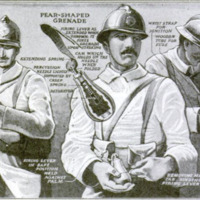Different types of grenades used during World War I
Contenuto
-
Titolo
-
Different types of grenades used during World War I
-
Article Title and/or Image Caption
-
Title: How the Modern Grenadier Is Armed
-
Subtitle: An ancient practice that was revived by the trench fighting of the great war
-
extracted text
-
THE hand grenade was used by the
French us early as the sixteenth
century. During ‘the present war
several types of this weapon have |
been evolved. There are two principal
types of hand grenades in use. One
type is exploded by a time-fuse, the |
other on striking the ground or some
other resisting object.
The Besozzi grenade has a time- |
fuse which causes the explosion |
of the charge of the grenade five
seconds after its ignition, The free
end of the fuse has a match-tip which |
is ignited by striking it with a ring
worn on the grenade-thrower's left
hand. Within five seconds af |
ter ignition, the grenade must be
at a safe distance from the thrower |
and within the enemy's lines. The
cast-steel body of the weapon is
deeply grooved to assist in frag |
mentation. |
The impact type of grenade is rep-
resented by the pear-shaped grenade
shown in the middle of the accom-
panying picture. It has a firing
lever, with a cam which holds up |
the firing needle when the lever is |
folded against the side of the |
grenade. The end of the levers held
in place by a strap which must be
removed before the bomb is thrown. |
‘When the grenade leaves the hand
of the thrower, the arm of the lever
is swung through an are of 180 degrees
by a spring, and the cam releases the
firing pin.
The ball grenade is made to explode
by a time-fuse. The fuse is enclosed
in a wooden tube which forms the
neck of the bomb. It is ignited by
pulling out a friction pin. The
soldier about to throw the grenade
hooks the wrist strap of his throwing
hand to the ring of the friction pin.
When the grenade leaves his hand, the
friction pin is jerked out, thereby
igniting the fuse, which explodes the
charge, usually after five seconds.
-
Autore secondario
-
Underwood & Underwood (Image copyright)
-
Lingua
-
eng
-
Data di rilascio
-
1919-01
-
pagine
-
14
-
Diritti
-
Public domain (Google digitized)
-
Archived by
-
Davide Donà
-
Marco Bortolami (editor)
 Screenshot (340).png
Screenshot (340).png